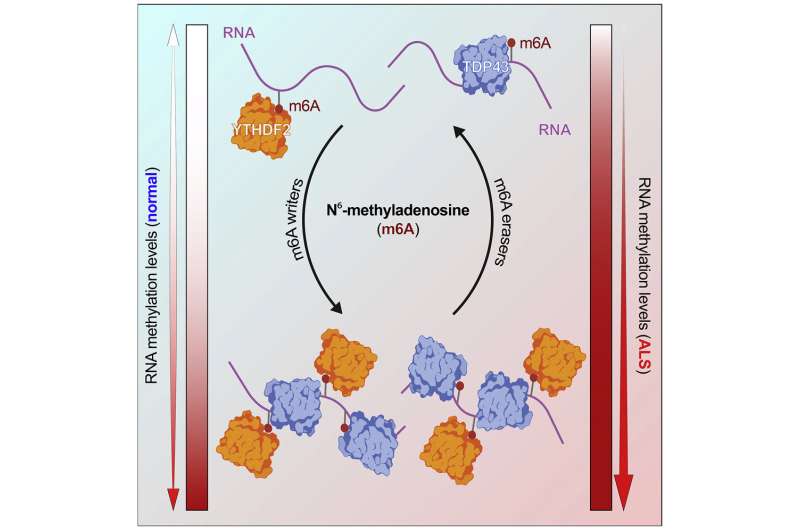This article has been reviewed according to Science X's editorial process and policies. Editors have highlighted the following attributes while ensuring the content's credibility:
fact-checked
peer-reviewed publication
trusted source
proofread
RNA modification 'pivotal' for protein linked to neurodegeneration in ALS

Nearly 100% of cases of amyotrophic lateral sclerosis—the progressive, fatal neurodegenerative disease known as ALS or Lou Gherig's disease—involve the buildup of a protein called TDP-43.
Scientists know that TDP-43, which helps regulate processing of RNA, may be responsible for the death of nerve cells in ALS and frontotemporal dementia. Previous studies by investigators at Michigan Medicine found that too much TDP-43 in the cells of patients caused the RNA to become very unstable.
And a study published in Molecular Cell suggests that a common modification to RNA plays a pivotal role in TDP-43-related neurodegeneration in ALS.
Researchers at Michigan Medicine focused on the most abundant RNA modification, a methylation event known as m6A. Through sequencing analysis, investigators showed that methylation strongly influences the binding of TDP-43 to its RNA targets. They also observed highly abundant RNA methylation in the end-stage tissues of patients with ALS.
"This is an RNA modification that has escaped our attention in the past, and yet it is rampant in patients with ALS," said Sami Barmada, M.D., Ph.D., senior author and Angela Dobson Welch and Lyndon Welch Research Professor of Neurology at University of Michigan Medical School.
"Despite the fact that we see all this RNA methylation, it's hard to say exactly what it means," Barmada said. "It's like watching the end of the movie and then trying to work out the plot. We see RNA methylation, TDP-43 buildup and loss of brain cells, but how are these connected?"
Previous studies suggest that total levels of m6A in the nervous system rise with age and that (some) neurodegenerative diseases are characterized by RNA hypermethylation. Importantly, RNA methylation is modified by environmental exposure.
Its presence in ALS, Barmada says, opens up a wide range of possibilities for research of a disease that is intimately linked to environmental exposure, as demonstrated by Stephen Goutman, M.D., M.S., and Eva Feldman, M.D., Ph.D., at Michigan Medicine.
More information: Michael McMillan et al, RNA methylation influences TDP43 binding and disease pathogenesis in models of amyotrophic lateral sclerosis and frontotemporal dementia, Molecular Cell (2023). DOI: 10.1016/j.molcel.2022.12.019



















